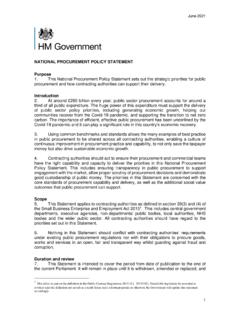Transcription of DELIVERY MODEL ASSESSMENTS - GOV.UK
1 DELIVERY MODEL ASSESSMENTS GUIDANCE NOTE MAY 2021 DELIVERY MODEL ASSESSMENTS MAY 2021 2 Contents Context 4 Overview 4 Contact 4 What is a DELIVERY MODEL assessment ? 5 Approach 5 Timing 6 Structure of a DELIVERY MODEL assessment 6 Why run a DELIVERY MODEL assessment ? 8 Selecting the right DELIVERY MODEL 8 When is a DELIVERY MODEL assessment required? 9 Completing a DELIVERY MODEL assessment 9 Before you start the DELIVERY MODEL assessment 10 Step 1 Frame the Challenge 10 Putting in place the right people 10 Governance and Working Groups 10 Running the DELIVERY MODEL assessment 12 Step 2 - Define the service and DELIVERY options 12 Defining the service 12 Deciding potential DELIVERY models to evaluate 13 Step 3 - Identifying the Strategic and Operational Evaluation Criteria 13 Setting and Weighting Evaluation criteria 13 Identify key data inputs 18 Gathering Data and Supporting Evidence 18 When considering outsourcing a service 18 Key considerations 18 When considering
2 Insourcing a service 19 Key considerations 19 Mixed economy approaches 20 Cost Evaluation 21 Step 4 - Building the Should Cost MODEL 21 Using Should Cost Models to understand whole life costs 21 Evaluating potential DELIVERY models against the strategic and operational criteria 22 Step 5 - Conducting the Evaluation 22 Evaluation process 22 Evaluating the results of the DELIVERY MODEL assessment 23 Step 6 - Aligning cost and non-cost evaluations 23 Reaching a recommendation 23 Finalising the DELIVERY MODEL assessment 24 DELIVERY MODEL ASSESSMENTS MAY 2021 3 Step 7 - Recommendations and approvals 24 Documenting the assessment 24 Iterating over time 24 Piloting and implementation (Step 8) 25 When outsourcing a service 25 Delivering a service in-house - applying the same standards 25 Appendix I: Framework to create a service definition and technical specification 27 Appendix II: Suggested Prerequisites for conducting a DELIVERY MODEL assessment 29 Strategy, Purpose and Scope 29 Stakeholders and Governance 29 Data Availability 29 Cost Analysis 30 Appendix III: Examples of potential supporting evidence 31 DELIVERY MODEL ASSESSMENTS MAY 2021 4 1.
3 Context Overview This note builds on chapter 3 in the Sourcing Playbook to provide more detailed guidance for departments on carrying out a DELIVERY MODEL assessment in order to decide whether to deliver a service, or part of a service, in-house, procure from the market or adopt a hybrid solution. It is aimed at supporting departments in creating and running an analytical, evidence-based approach and outlines the factors departments should consider as part of a DELIVERY MODEL assessment , as well as highlighting some of the common challenges faced by the Government in outsourcing or insourcing a service. Contact For complex projects you should consult the Cabinet Office before beginning the DELIVERY MODEL assessment .
4 The Sourcing Programme provides support to complex outsourcing projects in collaboration with the Complex Transactions team who have developed a detailed methodology and provide independent facilitation for DELIVERY MODEL ASSESSMENTS . DELIVERY MODEL ASSESSMENTS MAY 2021 5 2. What is a DELIVERY MODEL assessment ? Approach The DELIVERY MODEL assessment (previously referred to as a Make or Buy decision ) is an analytical, evidenced based approach to assist reaching a recommendation on whether a department should deliver a service, or part of a service, in-house, procure from the market or adopt a hybrid solution. In the public sector, DELIVERY MODEL decisions often need to consider a wide variety of potential supply options other than just the use of departmental resources (in-house) or the third party supply market.
5 The use of the wider public sector (such as Arms Length Bodies and Local Authorities), regulatory bodies or the use of the third sector, as well as the potential to establish joint ventures or GovCos may all be viable alternatives. It is a strategic decision that should be given consideration with an appropriate level of analysis and attention applied. If there is insufficient oversight and assurance placed on this fundamental analysis, particularly where a project is progressed at speed, this will create significant operational, commercial and reputational risks. However, a DELIVERY MODEL assessment is not: A substitute for a Target Operating MODEL the DELIVERY MODEL may help inform the final operating MODEL but will not design the future state of operations A budgeting mechanism in the DELIVERY MODEL assessment process.
6 A Should Cost MODEL will support decision-making but is unlikely to be sufficiently detailed to build a comprehensive future budget A sourcing MODEL assessment or supply strategy within the DELIVERY MODEL assessment you may consider the future approach to the external market but you will not develop a full specification of service requirements that might be needed for a tender or supply contract A supplier evaluation the objective is to assess the mechanism for approaching markets, rather than evaluating the capability of individual suppliers The DELIVERY MODEL assessment can help you identify and mitigate the different challenges that come from outsourcing or insourcing a service, or one of its components.
7 Services carry different risks and your evaluation should be designed to consider the particular challenges of insourcing ( building the right capability) and outsourcing ( transferring risks appropriately). The structured, evidence-based approach, set out in Figure 1, provides a framework to assess these factors, consistent with the options appraisal approach prescribed in the Green Book. The DELIVERY MODEL assessment should be proportional to the criticality, complexity and size of the project. DELIVERY MODEL ASSESSMENTS MAY 2021 6 Timing The length of time required for a DELIVERY MODEL assessment will depend on the complexity of the service, the availability of data to support decisions and the availability of resources to conduct the assessment .
8 As an indication, it can take 3-6 months for an initial DELIVERY MODEL assessment of mid-level complexity. Some suggested prerequisites for conducting an efficient DELIVERY MODEL assessment are included in Appendix II. The initial assessment is ideally conducted during the Strategic Outline Case and iterated throughout the business lifecycle (new data inputs are reviewed and assumptions are reviewed at each stage). This reinforces the importance of getting started early. Structure of a DELIVERY MODEL assessment Figure 1 sets out the eight steps of a DELIVERY MODEL assessment , their purpose and what they entail. The DELIVERY MODEL assessment process is, however, designed to be flexible and to accommodate a wide variety of services and needs.
9 Whilst all projects will need to go through all eight steps, the time and depth required for each step of the process may differ according to the needs of each project. In addition, elements of steps 2 to 4 are likely to be conducted in parallel with each other for example, it is often impossible to understand the data needs without understanding the evaluation criteria and as options evolve, the Should Cost MODEL may need to be adapted. DELIVERY MODEL ASSESSMENTS MAY 2021 7 Figure 1: DELIVERY MODEL assessment Approach and Steps DELIVERY MODEL ASSESSMENTS MAY 2021 8 3. Why run a DELIVERY MODEL assessment ? Selecting the right DELIVERY MODEL The selection of an appropriate service DELIVERY MODEL at the outset of a project has a significant impact on the Government s ability to achieve good service levels and value for money.
10 An evidence-based structured methodology is essential to assess which service DELIVERY MODEL offers best value for money, consistent with the options appraisal approach prescribed in the Green Book. Outsourcing, done well, can: Give management space to focus on core departmental priorities and free up resources that can be deployed more effectively Leverage greater scale and efficiencies from the market, where suppliers within that market are operating at scale Bring dynamism from a diverse marketplace of suppliers Draw on innovative new approaches and expertise which may not be available in the public sector With appropriate contractual flexibility, adapt to changing circumstances.











